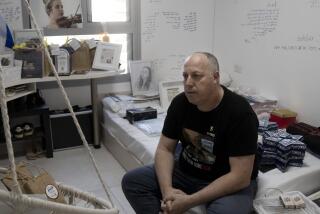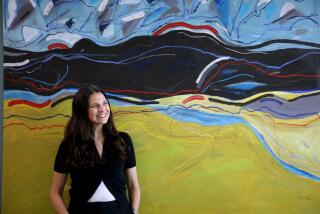Tel Aviv: A modern city in an ancient land
I expected to be transformed by my first visit to Israel, and especially Jerusalem, the cradle of three faiths, a traveler’s Holy Grail.
But when I returned to Rome for Christmas, I was surprised to realize that what I remember most is not ancient, spiritual Jerusalem but secular, young Tel Aviv, celebrating its 100th anniversary next year by mounting concerts in Yitzhak Rabin Square and restoring its 8-mile-long oceanfront promenade.
I think of the city’s long, luscious beaches, of its eye-catching Bauhaus architecture brought to Palestine by German refugees in the early 20th century, of its brightness, prosperity and style. I think of getting to know it with my old friend Penny Kaganoff, a rabbi’s daughter who helped me see the city through her eyes.
In Israel, everything -- be it a hill or a hat -- seems to have at least three meanings. For someone like me, whose knowledge of the Holy Land was forged in Sunday school, spending time here with a Jewish friend was like having a pair of magic glasses.
Late one afternoon we found the old Jewish cemetery on Trumpeldor Street in central Tel Aviv, where many city luminaries were buried. In the thickening twilight, Penny scrambled down a flight of uneven stone steps while I stood at the entrance. The burial ground looked to me like most others, except that the graves were marked by table-like slabs bearing Hebrew inscriptions and stones left by visitors, as in the unforgettable last scene of “Schindler’s List.”
“Oh, my God,” Penny called out. “This is the grave of Bialik. And here’s Gutman.”
Earlier we had visited the homes of Haim Nahman Bialik, a Russian-born poet and translator who helped make Hebrew the lingua franca of Israel, and a museum dedicated to the artist Nahum Gutman, who celebrated the young Jewish state in painting, both of which I found interesting. But discovering their graves meant something sharper and more personal to Penny.
She is my smart, passionate and funny friend from New York. If she’d been born a boy, she’d have been a rabbi, I figure, but her tradition-bound Jewish parents had three daughters. Still, she knows the Torah, speaks Hebrew and often travels to Israel because her older sister married an Israeli and lives here.
When I heard Penny was coming to Israel to attend her niece’s wedding, I made plans to meet her in Tel Aviv. After that we spent two days in the Upper Galilee and then I drove her to her sister’s for Shabbat while I saw Jerusalem on my own.
The U.S. State Department warns travelers about visiting Israel, especially in Palestinian-controlled areas like the West Bank, a short drive from Tel Aviv. Terrorist attacks, including the ubiquitous bus bombings, have subsided in the last few years. So I took advantage of this relative lull in hostilities to see the Holy Land.
Tight security at Tel Aviv’s Ben Gurion International Airport -- where it took me a full three hours to pass through security before an international departure -- brought the grim reality of the Israeli-Palestinian conflict home to me.
Shoppers’ bags are checked at the entrances of central Tel Aviv’s charming Nahalat Binyamin crafts market, and a young waitress at a cafe who looked like a varsity cheerleader told us she was about to start her two-year stint in the army.
Penny was delayed one morning on her way into the city from her sister’s suburb of Ra’anana about 10 miles north when a car bomb went off, fraying nerves and snarling traffic. The explosion, we learned later, was an organized crime killing, not a terrorist attack. The second intifada, launched in late September 2000, is thought to have killed more than 6,000 civilians and military personnel.
But the Mediterranean sun shone benignly while I was in Tel Aviv, a modern, high-rise city of about 400,000 that reminded me of Miami. It is as fresh and tart as a glass of fresh pomegranate juice.
It is a mark of how safe I felt in Tel Aviv that I could imagine the daily potential for violence only as I spent my jet-lagged nights rereading “Exodus,” Leon Uris’ novel about the country’s painful birth in 1948.
There are, doubtless, more searching, scholarly books about the country’s modern history. But “Exodus,” a historical novel about how a handful of Jewish pioneers started arriving in the Holy Land in the 19th century, put the Palestinian desert under cultivation and built leafy, graceful cities in the sand dunes, was just right for me.
Street names in Tel Aviv recall many of the figures I got to know in Uris’ 1958 novel, such as Joseph Trumpeldor, a famous Jewish soldier who died in a 1920 firefight near the Lebanese border, and Theodor Herzl, an Austrian writer considered the father of Zionism, which championed a Jewish nation in Palestine.
To appreciate Tel Aviv’s past, it’s best to start at Rokach House in the Neve Zedek neighborhood. The endearing, copper cupola-topped house was built in 1887 by Shimon Rokach, whose family was established in the Holy Land when modern immigration accelerated, fueled by pogroms and Zionism.
As the number of immigrants swelled, Jewish leaders moved out of old enclaves to found new colonies. Neve Zedek was one of the first to be settled. A handful of families moved to what was then a wasteland but later became known as “Little Paris.”
Their lifestyles are described in displays at the Rokach House, with its beautifully set Sabbath dinner table and bougainvillea-bowered patio, lined with vintage tile.
Across the street, the Nahum Gutman Museum has a permanent exhibition of the artist’s affable Tel Aviv streetscapes and a marvelous temporary show of illustrations by 19th century visitors to the Holy Land.
I paused at “Jews Before the Wall of Solomon,” an 1860 engraving by French artist Alexandre Bida, while Penny explained that Jewish people customarily tuck bits of paper bearing prayers in the cracks of Jerusalem’s Western Wall, all that remains of the Second Temple built about 2,000 years ago by King Herod.
After that we explored Neve Zedek, now one of Tel Aviv’s trendiest neighborhoods. It’s filled with cafes, galleries and boutiques such as Birkata on Yechiely Street, where Penny pointed out a pair of clunky platform shoes that are all the rage with Israeli women.
When it got late we stopped at Suzana, a restaurant near the Suzanne Dellal Centre, home of the Batsheva Dance Company founded in 1964 by Martha Graham and the Baroness Batsheva de Rothschild. The many-branched Rothschild family contributed greatly to Israel, Penny told me as I sampled a plate of delicious stuffed figs, leeks and peppers.
The dish had such a ripeness and bounty that it made Penny think of a passage from the Book of Deuteronomy describing the richness of ancient Israel, a “land of wheat and barley and vines and fig trees and pomegranates; a land of oil, olives and honey.”
The next morning at Tel Aviv’s busy Carmel Market, she made sure I got to taste freshly squeezed pomegranate juice, which was delicious.
We strolled along tree-lined Rothschild Boulevard, Tel Aviv’s best address when it was built in 1910 and still an architectural marvel. Its buildings illustrate the Colonial style (favored when Palestine was a British protectorate); Art Deco and the Bauhaus, or International Style, with its rounded corners, white stucco and unornamented facades.
We stopped to see Independence Hall, where the leaders of the Jewish community in Palestine, led by David Ben-Gurion, proclaimed the founding of the state of Israel immediately after the British left in May 1948.
Penny, who says she cries every time she goes to the Western Wall, got misty-eyed at Independence Hall. After that she caught a bus back to her sister’s house and I went back to my hotel where I sat on the roof terrace.
I thought about Herzl and Trumpeldor, the founding of Israel and the history of the Jews everywhere apparent in the sparkling city of Tel Aviv.
The air was fresh and cool. I could hear the sound of traffic from Hayarkon Street and saw lights blinking on near the beach. These struck me as good signs of everyday life in a city where crime bosses, not innocent citizens, are the ones who die in car bombs.
That is how I hope always to think of Tel Aviv.
More to Read
Sign up for The Wild
We’ll help you find the best places to hike, bike and run, as well as the perfect silent spots for meditation and yoga.
You may occasionally receive promotional content from the Los Angeles Times.






